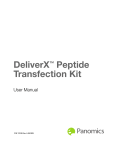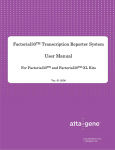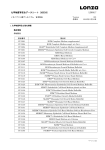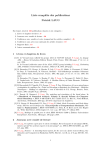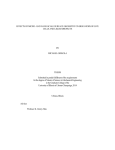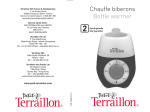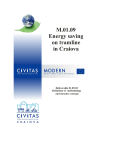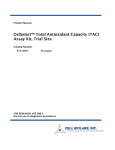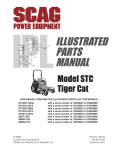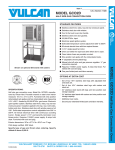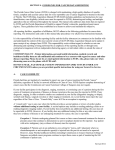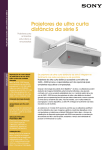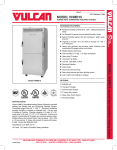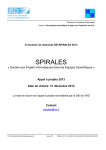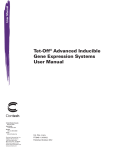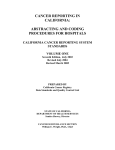Download DeliverX™ and DeliverX Plus siRNA Transfection Kits
Transcript
DeliverX and DeliverX Plus siRNA Transfection Kits ™ User Manual P/N 10586.060504 Rev. A DRAFT May 4, 2006 4:41 pm DeliverXTtile.fm Panomics, Inc. DeliverX and DeliverX Plus siRNA Transfection Kit User Manual Copyright © Copyright 2006, Panomics, Inc. All rights reserved. Trademarks DeliverX is a trademark of Panomics, Inc. QuantiGene is a registered trademark exclusively licensed to Panomics, Inc. All other trademarks belong to their respective owners. Citing DeliverX in Publications When describing a procedure for publication using this product, we would appreciate it if you would refer to it as the DeliverX™ siRNA Transfection Kit or DeliverX™ Plus siRNA Transfection Kit. If a paper cites a DeliverX product and is published in a research journal, the lead author(s) may receive a travel stipend for use at a technology conference or tradeshow by sending a copy of the paper to our technical support group at [email protected] or via fax at (510) 818-2610. Licenses DeliverX and DeliverX Plus transfection reagents are manufactured and distributed by Panomics, under license from CNRS (France). Disclaimer Panomics, Inc. reserves the right to change its products and services at any time to incorporate technological developments. This manual is subject to change without notice. Although this manual has been prepared with every precaution to ensure accuracy, Panomics, Inc. assumes no liability for any errors or omissions, nor for any damages resulting from the application or use of this information. DRAFT May 4, 2006 4:41 pm DeliverXTtile.fm Contents DeliverX and DeliverX Plus siRNA Transfection Kit and Manual Overview . . . . . . . . . . 5 About the Kits . . . . . . . . . . . . . . . . . . . . . . . . . . . . . . . . . . . . . . . . . . . . . . . . . . . . 5 About the Manual . . . . . . . . . . . . . . . . . . . . . . . . . . . . . . . . . . . . . . . . . . . . . . . . . 5 DeliverX and DeliverX Plus siRNA Transfection Kit Contents and Storage . . . . . . . . . . 6 Contents and Storage of DeliverX Kit. . . . . . . . . . . . . . . . . . . . . . . . . . . . . . . . . . 6 Contents and Storage of DeliverX Plus Kit. . . . . . . . . . . . . . . . . . . . . . . . . . . . . . 6 Storage Recommendations . . . . . . . . . . . . . . . . . . . . . . . . . . . . . . . . . . . . . . . . . 6 Safety Warnings and Precautions . . . . . . . . . . . . . . . . . . . . . . . . . . . . . . . . . . . . 6 Required and Recommended Materials Not Provided. . . . . . . . . . . . . . . . . . . . . . . . . . 6 Materials Required But Not Provided . . . . . . . . . . . . . . . . . . . . . . . . . . . . . . . . . . 6 Materials Recommended But Not Provided . . . . . . . . . . . . . . . . . . . . . . . . . . . . . 7 Assay Workflow and Recommended Guidelines, Controls and Optimization . . . . . . . . 7 Assay Workflow . . . . . . . . . . . . . . . . . . . . . . . . . . . . . . . . . . . . . . . . . . . . . . . . . . 7 Transfection Guidelines . . . . . . . . . . . . . . . . . . . . . . . . . . . . . . . . . . . . . . . . . . . . 7 Recommended Controls . . . . . . . . . . . . . . . . . . . . . . . . . . . . . . . . . . . . . . . . . . . 8 Optimizing Transfections . . . . . . . . . . . . . . . . . . . . . . . . . . . . . . . . . . . . . . . . . . . 8 Preparing the Cells the Day Before Transfection. . . . . . . . . . . . . . . . . . . . . . . . . . . . . . 9 Adherent Cell Types . . . . . . . . . . . . . . . . . . . . . . . . . . . . . . . . . . . . . . . . . . . . . . . 9 Suspension Cells or Adherent Cells in Suspension . . . . . . . . . . . . . . . . . . . . . . . 9 Preparing the siRNA/siRNA Transfection Reagent Complex. . . . . . . . . . . . . . . . . . . . 10 About Preparing the Complex . . . . . . . . . . . . . . . . . . . . . . . . . . . . . . . . . . . . . . 10 Procedure. . . . . . . . . . . . . . . . . . . . . . . . . . . . . . . . . . . . . . . . . . . . . . . . . . . . . . 10 Transfecting Adherent Cells. . . . . . . . . . . . . . . . . . . . . . . . . . . . . . . . . . . . . . . . . . . . . 12 Assay Preparation . . . . . . . . . . . . . . . . . . . . . . . . . . . . . . . . . . . . . . . . . . . . . . . 12 Procedure. . . . . . . . . . . . . . . . . . . . . . . . . . . . . . . . . . . . . . . . . . . . . . . . . . . . . . 12 Transfecting Cells in Suspension. . . . . . . . . . . . . . . . . . . . . . . . . . . . . . . . . . . . . . . . . 13 About Transfecting Cells in Suspension. . . . . . . . . . . . . . . . . . . . . . . . . . . . . . . 13 Assay Preparation . . . . . . . . . . . . . . . . . . . . . . . . . . . . . . . . . . . . . . . . . . . . . . . 13 Procedure. . . . . . . . . . . . . . . . . . . . . . . . . . . . . . . . . . . . . . . . . . . . . . . . . . . . . . 13 Scaling Transfections. . . . . . . . . . . . . . . . . . . . . . . . . . . . . . . . . . . . . . . . . . . . . . . . . . 14 About Preparing Bulk siRNA/siRNA Transfection Reagent Complexes. . . . . . . 14 Procedure. . . . . . . . . . . . . . . . . . . . . . . . . . . . . . . . . . . . . . . . . . . . . . . . . . . . . . 14 Transfection Guidelines for Different Well Sizes . . . . . . . . . . . . . . . . . . . . . . . . . . . . . 15 Adherent Cells . . . . . . . . . . . . . . . . . . . . . . . . . . . . . . . . . . . . . . . . . . . . . . . . . . 15 Cells in Suspension . . . . . . . . . . . . . . . . . . . . . . . . . . . . . . . . . . . . . . . . . . . . . . 15 Troubleshooting . . . . . . . . . . . . . . . . . . . . . . . . . . . . . . . . . . . . . . . . . . . . . . . . . . . . . . 16 Problems and Recommended Actions . . . . . . . . . . . . . . . . . . . . . . . . . . . . . . . . 16 Contacting Panomics . . . . . . . . . . . . . . . . . . . . . . . . . . . . . . . . . . . . . . . . . . . . . . . . . . 17 Technical Help . . . . . . . . . . . . . . . . . . . . . . . . . . . . . . . . . . . . . . . . . . . . . . . . . . 17 For Additional Services . . . . . . . . . . . . . . . . . . . . . . . . . . . . . . . . . . . . . . . . . . . 17 DeliverX and DeliverX Plus Kit User Manual Page iii DeliverX and DeliverX Plus siRNA Transfection Kit and Manual Overview DeliverX and DeliverX Plus siRNA Transfection Kit and Manual Overview About the Kits DeliverX siRNA reagents are available in two formats. Our DeliverX siRNA Transfection Kit is suitable for transfection of most cell types. DeliverX siRNA Transfection Kits contain the reagents required to efficiently transfect siRNAs into most cell types with minimal cell damage and good reproducibility when following the optimization guidelines provided in this User Manual. Panomics’ DeliverX Plus siRNA Transfection Kit is a validated solution for many cell types. Our DeliverX Plus siRNA Transfection Kits contain reagents particularly well-suited for transfection of classically difficult-to-transfect cell types and comes with a certificate of analysis for each lot and validated protocols for a number of cell types. There are currently 18 validated cell type specific protocols with additional protocols being introduced on a monthly basis. The validated cell types protocols are: 3T3-L1 (differentiated mouse adipocytes), HepG2, C2C12 (undifferentiated mouse myocytes), C2C12 (differentiated mouse myotubes), U87MG, HUVEC, BSMC, Astrocytoma human cells, NHEK-AD, MDA-MB-231, HT29, RAW 264.7, A549, SW620, THP-1, A2780, ASPC-1, and MCF-7. Note Visit our website at www.panomics.com for the most up-to-date list of validated cell-specific protocols available with our DeliverX Plus kits. Regardless of which solution suits your needs, each of these reagents offers unrivalled efficiency, minimal toxicity and a simple workflow. DeliverX Transfection Mechanism DeliverX transfection reagents are based on the novel delivery technology called “MPG”. This technology was developed at Centre de Recherches en Biochimie Macromoléculaire (CNRS) in Monpellier France in the laboratory of Dr. F. Heitz and Dr. G. Divita. MPG technology uses virus-derived amphipathic peptides that directly interact with nucleic acid cargos to form non-covalent nanoparticles (150-200 nm) capable of diffusing through the plasma membrane and releasing their contents inside the cell. The mechanism of entry is receptor-independent, involves MPG/lipid interactions, and avoids the endocytic pathway, thereby preventing endosomal or lysosomal degradation of cargos. About the Manual The manual contains a description of the kit contents and guidelines, recommendations and procedures for performing transfections using the DeliverX siRNA and DeliverX Plus siRNA Kits. DeliverX and DeliverX Plus Kit User Manual Page 5 DeliverX and DeliverX Plus siRNA Transfection Kit Contents and Storage DeliverX and DeliverX Plus siRNA Transfection Kit Contents and Storage Contents and DeliverX siRNA Transfection Kit Contents Storage of Storage DeliverX Kit Component DeliverX siRNA Transfection Reagent –20 °C DeliverX siRNA Buffer-1 RT DeliverX siRNA Buffer-2 RT Contents and DeliverX Plus siRNA Transfection Kit Contents Storage of Storage DeliverX Plus Kit Component DeliverX Plus siRNA Transfection Reagent Storage ♦ Recommendations ♦ –20 °C DeliverX Plus siRNA Buffer-1 RT DeliverX Plus siRNA Buffer-2 RT Divide transfection reagent into 50–100 μL aliquots to minimize freeze/thaw cycles. Store components at recommended temperatures. Product shelf life is 6 months from date of shipment, if stored properly. Safety Warnings CAUTION All chemicals should be considered potentially hazardous. We recommend that and Precautions this product and its components be handled by those trained in laboratory techniques and be used according to the principles of good laboratory practice. For research use only. Do not use internally or externally in humans or animals. Required and Recommended Materials Not Provided Materials Required But Not Provided Page 6 Item Source Cell culture reagents and equipment Major laboratory suppliers (MLS) Tris-EDTA buffer (TE), pH 8.0 P/N 9849 (Ambion, Inc.) Phosphate buffered saline, pH 7.2 (PBS) P/N 70013-032 (Invitrogen) siRNA for silencing target of interest MLS mRNA and or protein detection method following siRNA knockdown Panomics, Inc. for mRNA quantitation (P/N QG0001) Ultrasonic cleaner (bath sonicator) with 30-40 kHz sonication Panomics, Inc. (P/N DX0400) or equivalent DeliverX and DeliverX Plus Kit User Manual Assay Workflow and Recommended Guidelines, Controls and Optimization Materials Recommended But Not Provided Item Source QuantiGene® Reagent System for mRNA quantitation Panomics, Inc. (P/N QG0001) FAM-labeled siRNA control Panomics, Inc. (P/N DX0100) GAPDH siRNA control (human) Panomics, Inc. (P/N DX0101) Negative siRNA control MLS Assay Workflow and Recommended Guidelines, Controls and Optimization Assay Workflow Time Required 1. Prepare Adherent Cells Variable, typically 16-24 hr a. Plate cells before transfection 2. Prepare Transfection Complex 30 min a. Prepare siRNA/Buffer-1 b. Prepare siRNA Transfection Reagent/Buffer-2 c. Combine siRNA/Buffer-1 and siRNA Transfection Reagent/Buffer-2 d. Incubate complex at 37 o C for 20 min 3. Transfect Cells/Knockdown Target 24-72 hr a. Add complex, incubate 3-5 min at RT b. Add serum-free media, incubate 2-4 hr at 37 o C, 5% CO2 c. Add complete media, incubate 24-72 hr at 37 o C, 5% CO2 4. Quantify mRNA and/or Protein Knockdown Transfection ♦ Guidelines ♦ Variable, depending on assay Use healthy cells in mid-log phase, not overgrown. Determine optimal transfection conditions and use cells within 4–20 passages. (Passage number is cell-type specific). ♦ Do not use antibiotics during transfection process. You can use antibiotics to maintain the cell line. ♦ Use high-quality, high-potency siRNAs. ♦ Sonicate the transfection reagent as stated in the procedure to ensure proper formation of the siRNA/siRNA transfection reagent complexes. Note Once the siRNA/siRNA transfection reagent complex has been formed properly, it can be diluted to obtain varying siRNA concentrations. ♦ Perform all procedures in a laminar-flow hood using proper tissue culture techniques. ♦ Run triplicates for each data point. DeliverX and DeliverX Plus Kit User Manual Page 7 Assay Workflow and Recommended Guidelines, Controls and Optimization Recommended Proficiency Controls Controls For new users or when working with a new cell type, we recommend the use of the following proficiency controls: ♦ FAM-labeled siRNA delivery control. This is a fluorescently-labeled control for visualizing siRNA transfection efficiency under a fluorescent microscope. ♦ Positive control siRNA. Use a validated, high-potency siRNA as a functional siRNA control. Robust knockdown of that target ensures that the assay conditions are optimal for the cell type. Routine Controls These controls assess the transfection and RNA knockdown efficiency and we recommend they be used routinely. ♦ Negative control siRNA. This control is typically an siRNA designed to have no homology to specified species and therefore no effect on mRNA or protein levels. This control enables you to quantitate the amount of the mRNA knockdown. Negative siRNA controls are also referred to as non-silencing or scrambled siRNAs. ♦ Positive control siRNA. This is a validated, high-potency siRNA whose functional response ensures that the assay is working in a reproducible manner. ♦ Cells only. This is a buffer-only control serving as a mock-transfection designed to monitor for any non-transfection related phenomenon during the experiment. This control contains the transfection buffers but does not include either the transfection reagent or siRNA. Note DeliverX or DeliverX Plus siRNA transfection reagent alone should not be used as a negative control as it is known to result in increased cytotoxicity. Optimizing Because cell types can differ significantly with respect to their capacity to be Transfections transfected, we recommend that you optimize the protocol empirically. The most important parameters for optimization are cell density and siRNA concentration. Cell Density Cell densities that are too high or too low may not take up an optimal amount of the complexes resulting in insufficient gene silencing or elevated levels of cytotoxicity. Lower cell densities may be necessary for post-transfection incubation times greater than 48 hours. siRNA Concentration The siRNAs capacity for gene silencing are influenced in part by the siRNA design and properties of the target gene. This may include mRNA localization, stability and abundance, and protein stability and abundance. If too much siRNA is used during transfection, you may see toxicity. If too little is used, you may not see adequate knockdown. Page 8 DeliverX and DeliverX Plus Kit User Manual Preparing the Cells the Day Before Transfection Preparing the Cells the Day Before Transfection Adherent Cell For most adherent cell types, the optimal confluency for transfection is 30–70%. The Types following table provides guidelines for seeding different sized culture vessels to obtain 30–70% confluence after 24 hours of growth. IMPORTANT Use cells from passages 4–20 (cell-type specific). Optimal cell density is very important for obtaining the best results. Note These numbers are approximate because the exact number of cells required depends on cell type, size, and growth rate. If you are using a... Then seed cells at a density of... In a volume of... 6-well plate 150–300 x 103 cells/well 2 mL/well 12-well plate 50–200 x 103 cells/well 1 mL/well 24-well plate 96-well plate 25–75 x 5–10 x 103 103 cells/well cells/well 500 μL/well 100 μL/well Suspension Cells Grow cells to 40–80% confluence or to mid-log phase. The following table provides or Adherent Cells guidelines for the number of cells required for running transfections in different sized in Suspension culture vessels. IMPORTANT Optimal cell density is very important for obtaining the best results Note These numbers are approximate because the exact number of cells required depends on cell type, size, and growth rate. If you are using a... Then resuspend cells at a density of... In a volume of... 0.3–0.9 x 106 cells/mL 12-well plate 0.1–0.4 x 106 cells/mL 24-well plate 5 x 106 cells/mL 30 μL/well 96-well plate 1 x 106 cells/mL 10 μL/well 6-well plate DeliverX and DeliverX Plus Kit User Manual 1 mL/well 1 mL/well Page 9 Preparing the siRNA/siRNA Transfection Reagent Complex Preparing the siRNA/siRNA Transfection Reagent Complex About Preparing Sonication of the DeliverX and DeliverX Plus Transfection Reagents per the the Complex procedure below is critical for proper formation of the complex used for transfection. Once the complex has been properly formed, it is amenable to dilution for evaluating a range of siRNA delivery concentrations. This novel peptide-based delivery system requires no optimization of the siRNA to transfection reagent ratio and enables high efficiency siRNA transfection typically with 30 nM or less. Procedure The following procedure prepares transfection complexes sufficient for the transfection of 13 wells of a 96-well plate, 4 wells of a 24-well plate, 2 wells of a 12-well plate, or 1 well of a 6-well plate. When scaling up the number of transfections to be performed or, when performing transfections in different sized wells, the amount of reagents should be scaled in proportion to the surface area of the plate well or dish (see “Scaling Transfections” on page 14 for more information). IMPORTANT We do not recommend scaling up reagent volumes greater than 3X when preparing the working siRNA/siRNA transfection reagent complexes. Instead, we recommend that multiple replicate working transfection complexes be prepared in parallel, then combined into a single tube to produce a bulk volume of working transfection complex. To prepare DeliverX or DeliverX Plus siRNA/transfection reagent complex: Step Action 1 Thaw siRNAs and DeliverX or DeliverX Plus Transfection Reagent and store on ice. 2 Prepare working stocks of siRNAs by diluting the siRNAs to 5 μM with TE buffer. 3 Dilute the 5 μM siRNA working stocks with Buffer-1 in 1.5 mL tubes as described in the table below. This preparation will yield a final siRNA delivery concentration of 30 nM. 5 μM siRNA Working Stocks (μL) 5 μM Negative Control siRNAa (μL) Buffer-1 (μL) Tube 1 Target siRNA 13 — 37 Tube 2 Negative Control siRNAa — 13 37 Tube 3 Cells only — — 50 Sample a. Recommended control not supplied with the kit. Page 10 DeliverX and DeliverX Plus Kit User Manual Preparing the siRNA/siRNA Transfection Reagent Complex To prepare DeliverX or DeliverX Plus siRNA/transfection reagent complex: (continued) Step 4 Action Prepare the DeliverX or the DeliverX Plus Transfection Reagent: a. Sonicate the DeliverX or DeliverX Plus siRNA Transfection Reagent at maximum output and continuous power for 3–5 minutes to achieve a homogenous solution. b. Prepare dilutions in 1.5 mL tubes as described in the table below. c. After diluting, vortex briefly and sonicate again at maximum output and continuous power for 3–5 minutes. IMPORTANT Sonication of DeliverX or DeliverX Plus siRNA Transfection Reagent is critical for achieving good complex formation. Ensure that the tubes are submerged in the water during sonication. DeliverX or DeliverX Plus siRNA Transfection Reagent (μL) Buffer-2 (μL) Tube 1 Target siRNA 8 42 Tube 2 Negative Control siRNAa 8 42 Tube 3 Cells only — 50 Sample a. Recommended control not supplied with the kit. 5 Form concentrated siRNA/siRNA transfection reagent complex: a. Match tubes with the same tube numbers from Step 2 and Step 3. b. Mix the siRNA/Buffer-1 solution (50 μL) from Step 2 with the siRNA Transfection Reagent/Buffer-2 solution (50 μL) from Step 3. c. Vortex for 3 seconds at speed 7, or pipet up-and-down several times. d. Incubate tubes at 37 °C for 20 minutes. 6 Prepare complex dilution buffer by mixing equal volumes of Buffer-1 and Buffer-2. For example, mix 500 μL of Buffer-1 and 500 μL of Buffer-2 to make 1,000 μL of complex dilution buffer. 7 Prepare working siRNA/siRNA transfection reagent complexes by adding 300 μL of complex dilution buffer to the concentrated complex (prepared in Step 4). The volume of each tube should be 400 μL. Use this working complex for transfection or serially dilute it with the complex dilution buffer before the transfection. DeliverX and DeliverX Plus Kit User Manual Page 11 Transfecting Adherent Cells Transfecting Adherent Cells Assay Preparation Pre-warm both serum-free and complete growth media to 37 °C. Procedure When performing transfections in different sized wells, scale the amount of reagents in proportion to the surface area of the plate well or dish. See “Scaling Transfections” on page 14 for more information. To transfect adherent cells grown in 96-well plates: Step Action 1 Carefully, remove media from the wells and wash once with 100 μL/well of PBS. 2 Add 30 μL/well of the working siRNA/siRNA transfection reagent complex. IMPORTANT Manually rock (do not swirl) the plate to evenly distribute the complex over the well surface. 3 Incubate at room temperature for 3–5 minutes. 4 Add 30 μL/well of serum-free media. 5 Incubate under normal cell-culture conditions, typically at 37 °C and 5% CO2, for 2–4 hours. Note 6 For maximum knockdown, we recommend 4 hours. Add 100 μL/well of complete growth media. At this step, the final concentration of siRNA in the sample is 30 nM. Note For cells that require a precise serum level, you may have to adjust the serum concentration. 7 Incubate under normal cell-culture conditions, typically at 37 °C and 5% CO2 for 24 hours or desired time intervals. Note 24–48 hour incubation times are typical when measuring mRNA knockdown. 48–72 hour incubation times are typical when measuring protein knockdown. For longer incubation times, you may need to change the media 24 hours post transfection. 8 Page 12 Measure mRNA and/or protein knockdown as appropriate. We recommend quantitating mRNA expression levels with the QuantiGene Reagent System. DeliverX and DeliverX Plus Kit User Manual Transfecting Cells in Suspension Transfecting Cells in Suspension About Transfecting This procedure describes the transfection of adherent cells after trypsinization and Cells in while they are in suspension. Transfect adherent cells in suspension when you want Suspension to do the treatment and transfection in the same day. The same procedure can also be used for suspension cell types. Note In some cases, this procedure improves the knockdown efficiency of adherent cell types. Assay Preparation ♦ ♦ Pre-warm both serum-free and complete growth media to 37 °C. Prepare adherent cells in suspension, if using, by trypsinizing the cells using your normal procedure and suspend them in complete growth media. Procedure When performing transfections in different sized wells, scale the amount of reagents in proportion to the surface area of the plate well or dish. See “Scaling Transfections” on page 14 for more information. To transfect cells in suspension in a 6-well format: Step Action 1 Pellet the cells in a 15 mL tube by spinning for 5 minutes at 400 x g. 2 Gently aspirate the media, avoiding cell loss, and resuspend the cells in 5 mL of PBS and spin again at 400 x g for 5 minutes. 3 Gently aspirate the PBS, avoiding cell loss, and resuspend the cells in PBS to a concentration of 0.3–0.9 x 106 cells/mL. 4 Dispense 1 mL aliquots into 2 mL microtubes. 5 Pellet the cells at 400 x g for 5 minutes. 6 Gently aspirate the PBS, avoiding cell loss and, resuspend with 300 μL of working siRNA/siRNA transfection reagent complex, as described in “Preparing the siRNA/siRNA Transfection Reagent Complex” on page 10. 7 Mix by pipetting up and down several times. 8 Incubate at room temperature for 3–5 minutes. 9 Add 300 μL of serum-free media to the tube and mix gently by pipetting up and down several times. 10 Transfer 600 μL of cells/transfection complex to each well of a 6-well plate and incubate under normal cell-culture conditions, typically 37 °C and 5% CO2, for 2–4 hours. Note 11 Add 1 mL/well of complete growth media. Note 12 For maximum knockdown, we recommend 4 hours. At this point the concentration of siRNA in the sample well is 30 nM. Incubate samples under normal cell-culture conditions for 24 hours or the desired time interval. Note 24–48 hour incubation times are typical when measuring mRNA knockdown. 48–72 hours incubation times are typical when measuring protein knockdown. For longer incubation times, you may need to change the media 24 hours post transfection. 13 Measure mRNA and/or protein knockdown as appropriate. We recommend quantitating mRNA expression levels with the Quantigene Reagent System. DeliverX and DeliverX Plus Kit User Manual Page 13 Scaling Transfections Scaling Transfections About Preparing Bulk siRNA/siRNA Transfection Reagent Complexes Because the complex formation is impaired when large volumes are prepared, we recommend scaling up the working siRNA/siRNA transfection reagent complex in 3X volume aliquots when preparing to transfect large sample numbers. Multiple replicate working transfection complexes should be prepared in parallel and then combined into a single tube to produce bulk volume of working transfection complexes. Procedure To scale-up working siRNA transfection complexes: Step Action 1 Determine the volume of working siRNA/siRNA transfection reagent complex required for your culture vessel size and assay design. 2 Use the table below to determine the number of 3X working transfection complexes required. 3 Prepare the required number of working siRNA/siRNA transfection reagent complexes in parallel, following the procedure on page 10 and using the volumes provided in the table below. 4 Combine the prepared working siRNA/siRNA transfection reagent complexes to form a single bulk solution. 5 Use this preparation for transfection or, if required, serially dilute with the complex dilution buffer before the transfection. Preparing multiple replicate 3X working siRNA/siRNA transfection reagent complexes in parallel for generating bulk volumes: Number of 3X Working Transfection Complexes Required Combined Bulk Working Transfection Complexes Required Wells of a 96-Well Plate Wells of a 24-Well Plate Wells of a 12-Well Plate Wells of a 6-Well Plate 1 1.2 mL 40 16 8 4 2 2.4 mL 80 32 16 8 3 3.6 mL 120 48 32 12 4 4.8 mL 160 64 48 16 5 6.0 mL 200 80 64 20 Scaling up working siRNA/siRNA transfection reagent complexes: Buffer-2 (μL) Complex Dilution Buffer (μL) Working Transfection Complex Formed (mL) 42 300 0.4 Scale 5 μM siRNA (μL) Buffer-1 (μL) siRNA Transfection Reagent (μL) 1X 13 37 8 2X 26 74 16 84 600 0.8 3x 39 111 24 126 900 1.2 Page 14 DeliverX and DeliverX Plus Kit User Manual Transfection Guidelines for Different Well Sizes Transfection Guidelines for Different Well Sizes Adherent Cells The tables below are a guideline, based on surface areas, for scaling the components of transfection for different well sizes. Preparing transfections of adherent cells using various sizes of wells: If you are using a... Using PBS, Wash cells with... Working siRNA Transfection Complex Serum-Free Media Complete Growth Media 6-well plate 500 μL 300 μL 300 μL 1,000 μL 12-well plate 300 μL 150 μL 150 μL 500 μL 24-well plate 150 μL 75 μL 75 μL 250 μL 96-well plate 100 μL 30 μL 30 μL 100 μL Cells in Suspension Preparing transfections of cells in suspension using various sizes of wells: If you are using a... Resuspend Cells with PBS to...(cells/mL) Cell Suspension Required/Well Working siRNA Transfection Complex Serum-Free Media Complete Growth Media 6-well plate 0.3–0.9 x 106 1,000 μLa 300 μL 300 μL 1,000 μL 12-well plate 0.1–0.4 x 106 1,000 μLa 150 μL 150 μL 500 μL 30 μLb 75 μL 75 μL 250 μL 10 μLb 30 μL 30 μL 100 μL 24-well plate 96-well plate 5x 106 1x 106 a. Spin cells down in a microtube, remove PBS, and resuspend cells with the working transfection complex. After adding the serum-free media, transfer the contents of the microtube to a single well of a 6-well or 12-well plate as appropriate. Add complete growth media. b. Add cell suspensions directly to the cell-culture plate. Perform all subsequent steps in the cell-culture plate. DeliverX and DeliverX Plus Kit User Manual Page 15 Troubleshooting Troubleshooting Problems and Recommended To troubleshoot transfections using DeliverX and DeliverX Plus kits: Actions Observation RNA knockdown not as expected High toxicity Page 16 Possible Cause Recommended Action Denatured siRNA Do not use water to dilute the siRNA which can cause denaturation of siRNA. Use 1X TE (pH 8.0) to dilute stock siRNA to 5 μM and DeliverX siRNA Buffer-1 to dilute siRNA during complex formation. Poorly designed siRNA Make sure the sequence of the siRNA is correct for the gene of interest. More than one sequence may need to be tested for optimal knockdown efficiency. Cell density not optimal Evaluate cell densities outside of the recommended 40–80% confluence at the time of transfection. Transfection time not adequate Evaluate transfection times greater than 4 hours. Sub-optimal post-transfection incubation time Test a range of 24–72 hours for post-transfection incubation time. Cell have a tendency to grow in groups or clumps Do not tap flask during trypsinization. Allow the cells to detach themselves. After trypsinizing the cells, pipet up and down several times to release the cells. Seed them at the desired density. Visually check by microscopy. Cell response changes after repeated passages Thaw fresh cells for subsequent experiments. Avoid using cells at early or late passages. Medium depletion For longer incubation times (48–72 hours), you may have to change the medium 24 hours post transfection. Alternatively, add additional complete medium at 24 hours. DeliverX or DeliverX Plus siRNA transfection reagent/siRNA complex not formed properly Do not exceed the recommended volume of transfection reagent when preparing the transfection reagent complex. Cell density too low Evaluate higher cell densities at the time of transfection. Be gentle when removing medium or PBS during washes. Cells become more sensitive to reagents after repeated passages Thaw fresh cells for subsequent experiments. Avoid using cells at early or late passages. Too much working transfection complex added to the cells Follow the recommended guidelines stated in the manual for addition of working transfection complex. DeliverX and DeliverX Plus Kit User Manual Contacting Panomics Contacting Panomics Technical Help For technical questions, contact our technical support group by telephone at 866-317-2626 or by email at [email protected], or visit our website www.panomics.com for an updated list of FAQs and product support literature. For Additional For information about Panomics products or for ordering information, contact your Services Regional Sales Manager, or visit our website at www.panomics.com. DeliverX and DeliverX Plus Kit User Manual Page 17


















